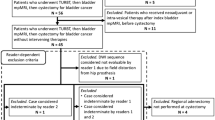Abstract
Background
Accurate evaluation of local extent in bladder cancer is important to determine the optimal therapeutic strategy and to predict the outcome of treatment. The purpose of this study is to evaluate the accuracy of 3D volumetric reconstructed US in the assessment of tumor detection and serosal invasion in patients with bladder cancer.
Methods
A total of 14 patients with findings of bladder cancer determined with the use of cystoscopy was examined with the use of bladder two-dimensional (2D) US and subsequent 3D US. US findings were compared with cystoscopy findings and the pathological stage after a TURB or a radical cystectomy in a double-blinded manner.
Results
The sensitivity of preoperative tumor staging was 67.9% for 2D US and sensitivity was 78.6% for 3D US. 3D US was superior sensitivity than 2D US (P < 0.05). The accuracy for serosal invasion in staging of bladder cancer was demonstrated for 88.9% in 2D US and for 100% in 3D US.
Conclusions
The accuracy for serosal invasion (T3b) in the staging of bladder cancer was demonstrated for 88.9% in 2D US and for 100% in 3D US. 3D volumetric reconstructed US is a non-invasive and accurate technique for tumor detection of bladder cancer.



Similar content being viewed by others
References
Arslan H, Ceylan K, Harman M, et al. (2006) Virtual computed tomography cystoscopy in bladder pathologies. Int Braz J Urol 32:147–154; discussion 154
Chatterton K, Ray E, O’Brien TS (2006) Fluorescence diagnosis of bladder cancer. Br J Nurs 15:595–597
Wong-You-Cheong JJ, Woodward PJ, Manning MA, et al. (2006) From the archives of the AFIP: neoplasmas of the urinary bladder: radiologic–pathologic correlation. Radiographics 26:553–580
Wagner B, Nesslauer T, Bartsch G, et al. (2005) Staging bladder carcinoma by three-dimensional ultrasound rendering. Ultrasound Med Biol 31:301–305
Koraitim M, Kamal B, Metwalli N, et al. (1995) Transurethral ultrasonographic assessment of bladder carcinoma: its value and limitation. J Urol 154:375–378
Kyle KF (1982) Ultrasound in the staging of bladder tumours: a review after 6 years. Br J Urol 54:65
Venz S, Ilg J, Ebert T, et al. (1996) Determining the depth of infiltration in urinary bladder carcinoma with contrast medium enhanced dynamic magnetic resonance tomography. With reference to postoperative findings and inflammation. Urologe A 35:297–304
Tsili A, Tsampoulas C, Chatziparaskevas N, et al. (2004) Computed tomographic virtual cystoscopy for the detection of urinary bladder neoplasms. Eur Urol 46:579–585
Westenfelder M, Rosset K, Pelz K (1987) Development of nosocomial and iatrogenic urinary tract infections (UTI) following urological interventions. A prospective clinical study. Scand J Urol Nephrol Suppl 104:59–63
Clark KR, Higgs MJ (1990) Urinary infection following out-patient flexible cystoscopy. Br J Urol 66:503–505
Paik ML, Scolieri MJ, Brown SL, et al. (2000) Limitations of computerized tomography in staging invasive bladder cancer before radical cystectomy. J Urol 163:1693–1696
Tsampoulas C, Tsili AC, Giannakis D, et al. (2008) 16-MDCT cystoscopy in the evaluation of neoplasms of the urinary bladder. AJR Am J Roentgenol 190:729–735
Riccabona M, Nelson TR, Pretorius DH, et al. (1995) Distance and volume measurement using three-dimensional ultrasonography. J Ultrasound Med 14:881–886
Murphy WM, Grignon DJ, Perlman EJ (2004) Tumors of the kidney, bladder, and related urinary structures. Washington DC: American Registry of Pathology, p. 394
Tekes A, Kamel IR, Imam K, et al. (2003) MR imaging features of transitional cell carcinoma of the urinary bladder. AJR Am J Roentgenol 180:771–777
Chan L, Lin WM, Uerpairojkit B, et al. (1997) Evaluation of adnexal masses using three-dimensional ultrasonographic technology: preliminary report. J Ultrasound Med 16:349–354
Pretorius DH, Nelson TR (1995) Fetal face visualization using three-dimensional ultrasonography. J Ultrasound Med 14:349–356
Salo JO, Kivisaari L, Lehtonen T (1998) Comparison of magnetic resonance imaging with computed tomography and intravesical ultrasound in staging bladder cancer. Urol Radiol 10:167–172
Elliot TL, Downey DB, Tong S, et al. (1996) Accuracy of prostate volume measurements in vitro using three-dimensional ultrasound. Acad Radiol 3:401–406
Pretorius DH, Nelson TR (1994) Prenatal visualization of cranial sutures and fontanelles with three-dimensional ultrasonography. J Ultrasound Med 13:871–876
Author information
Authors and Affiliations
Corresponding author
Rights and permissions
About this article
Cite this article
Park, H.J., Hong, S.S., Kim, J.H. et al. Tumor detection and serosal invasion of bladder cancer: role of three-dimensional volumetric reconstructed US. Abdom Imaging 35, 265–270 (2010). https://doi.org/10.1007/s00261-009-9529-4
Received:
Accepted:
Published:
Issue Date:
DOI: https://doi.org/10.1007/s00261-009-9529-4




